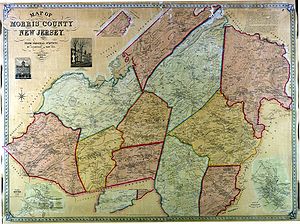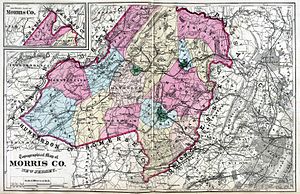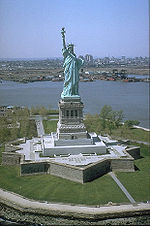- Morris County, New Jersey
-
Morris County, New Jersey 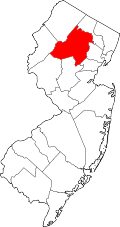
Location in the state of New Jersey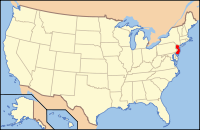
New Jersey's location in the U.S.Founded March 15, 1739 Seat Morristown Largest city Parsippany-Troy Hills Area
- Total
- Land
- Water
481 sq mi (1,246 km²)
469 sq mi (1,215 km²)
12 sq mi (31 km²), 2.55%Population
- (2010)
- Density
492,276
1,049/sq mi (405.1/km²)Website www.co.morris.nj.us Morris County is a county located in the U.S. state of New Jersey, about 25 mi (40 km) west of New York City. According to the United States 2010 Census, the population was 492,276. It is part of the New York Metropolitan Area. Its county seat is Morristown.[1]
Morris County was the eighth-wealthiest county in the United States by median household income, and ranked tenth by per capita income.[2] It is the ninth-wealthiest county in the United States by personal per-capita income, the highest rank in New Jersey.[3] The county ranked third in the New York Metropolitan area in terms of median income.[4]
Contents
History
Etymology
Morris County was named after Colonel Lewis Morris, governor of New Jersey in 1738/9, the year the county was named.[5]
Pre-columbian
The area of Morris County was inhabited by the Lenape prior to the coming of the Europeans. They lived along the rivers and hunted game, fished, collected plants and nuts.
From 1611 to 1614, the Dutch established the colony of New Netherland, which claimed territory between the 40th and 45th parallels, which included northern New Jersey.
The Native Americans traded furs and food with the Dutch for various goods. In return the Dutch gave the Native Americans metal pots, knives, guns, axes, and blankets. Trading with the Native Americans occurred until 1643 when a series of wars broke out between the Dutch and Native Americans due to various disagreements and misconceptions.[citation needed]
There were hostile relations between the Dutch and Native Americans between 1643 and 1660. This prevented colonization by the Dutch of the Morris County region which was technically included in their claimed "New Netherland."
On August 27, 1664, three English ships approached Fort Amsterdam and the fort was surrendered to the English. The English now controlled New Netherland and Morris County was now under control of the colony of New York. Relations with the Native Americans improved for a while.
There was a war with the Dutch ten years later. The Dutch re-took control of New Amsterdam but after a year returned it to the English. Relations with the Native Americans and English improved for a while.[citation needed]
European settlements began in the early 18th century while it was known as Hunterdon County. Native Americans were still in the area at that time. Land was purchased from the Native Americans for various things such as blankets, shirts, rum, guns, knives, pots and gun powder. The Native Americans' concept of selling land was different than that of the Europeans. Colonization occurred along the Atlantic coast and moved inland.
The first settlement in the area today known as Morris County occurred in Pompton Plains by the Dutch in 1695. From 1710 to 1730, various iron mines and forges were established. The first was in Whippany in 1710 and then in Succasunna in 1713.
By 1750, nearly all Native Americans had left New Jersey. This was due to land purchases from the Native Americans, diseases that the Native Americans contracted from Europeans, and due to starvation from the Little Ice Age. During the Little Ice age, Native American corn crops failed and rivers froze, preventing fishing. Snow storms sent game into semi-hibernation or made them difficult to find. Nut crops such as oak, hickory, beech, walnut, chestnut and butternut failed some years due to late frosts in spring. Due to all the events that happened, Native Americans went to eastern Canada and others went to the Ohio Valley. The Walking Purchase in September 1737, prevented Native Americans from going to eastern Pennsylvania. At that time, European settlement grew swiftly as there was now land to be farmed and settled.
Morris County was created on March 15, 1739, from portions of Hunterdon County.[6] The county was named for the Governor of the Province of New Jersey, Colonel Lewis Morris.[7] In later years Sussex County (on June 8, 1753) and, after the revolution, Warren County (on November 20, 1824, from portions of Sussex County) were carved out of what had been the original area of Morris County under English rule.[6]
The county was the site of the winter camp of the Continental Army after the Battles of Trenton and Princeton during the winter of 1777, as well as another winter camp at Jockey Hollow during an extremely cold winter of 1779–80 which occurred during the Little Ice Age.
Geography
According to the U.S. Census Bureau, the county has a total area of 481 square miles (1,250 km2), of which 469 square miles (1,210 km2) is land and 12 square miles (31 km2) (2.55%) is water.
The county rises in elevation and relief from east to west, with only the more developed eastern suburbs in the Passaic River valley being relatively level. The highest point is at 1,395 feet (425 m) above sea level on a mountain south of Pine Swamp in western Jefferson Township. The second highest point is on a mountain just north of Riker Lake at 1,358 feet (414 m). The lowest point is about 160 feet (45 m) in elevation, at Two Bridges, the confluence of the Passaic and Pompton rivers.
The county is drained by several rivers. The Rockaway River drains 125 square miles (320 km2), of the northern section of the county. The Whippany River drains 69 square miles (180 km2) of the middle of the county. The Black River drains the western area.
Most of the county's borders are rivers. The Pequannock drains the northern boundary area. The Pompton River drains the eastern section. The Passaic river also drains the eastern border area. The western border is drained by the Musconetcong River.
There are several large lakes in Morris County, among them are Lake Hopatcong, Budd Lake, Lake Parsippany, and the Jersey City Reservoir.
There are seven counties adjacent to Morris County:

Sussex County Passaic County 
Warren County 
Essex County  Morris County, New Jersey
Morris County, New Jersey 

Hunterdon County Somerset County Union County Geology
Around 500 million years ago, a chain of volcanic islands shaped like an arch collided with proto North America. The islands rode over top of the North American plate. This created the highlands in western Morris County and the eastern section of Morris County.[8]
Around 400 million years ago, a small continent long and narrow collided with proto North America. This created folding and faulting, as compression occurred. Then around 350 million years ago, the African plate collided with North America creating the folding and faulting in the Appalachians. But when the African plate pulled away from North America, an aborted rift valley was created. This half gruben, starts east of Boonton and goes through the middle of Parsippany, south to Morristown, to the south end of Great Swamp. From Parsippany and the Boonton area the half gruben goes east to the western side of Paterson, were there was another fault by the lava flows. East of the Ramapo Fault is where there is this aborted rift valley.[8] The Ramapo fault goes through the county on an northeast–southwest axis. The fault separates the Highlands from the Piedmont, also known as the Newark Basin. This is an active fault. The last major earthquake occurred in 1884.[citation needed]
Around 21,000 B.C., the Wisconsin Glacier covered about half of Morris County. The terminal morraine went from Hackettstown east to north of Budd Lake, east to Rockaway and Denville, then southeast to Morristown then south to the south end of Great Swamp. When the glacier melted around 13,000 B.C. the melt water created Glacial Lake Passaic. The lake extended from what is now Pompton Lakes through Parsippany south to the south end of Great Swamp. From Parsippany the lake went east to the lava flows of western Paterson. This lake was thirty miles long and ten miles wide (36 km by 12 km). The depth was about 200 feet (61 m). When the Wisconsin glacier cover Morris County the ice sheet was about 300 metres (980 ft) deep. Due to debris from the glacier, the lake was unable to drain through the Watchung Mountains near Short Hills. Instead, it drained through Moggy Hollow at the southwestern end of the lake. But when the glacier melted and receded to the New York State line, the lake drained though the Little Falls area, as this was lower in elevation than Moggy Hollow. And thus the Passaic river formed.
The swamps of the Great Piece Meadows, Hatfield swamp, Troy meadows, Lee Meadows and Great Swamp were all under the Lake Passaic until it drained, and then these areas were created.
National protected areas
- Great Swamp National Wildlife Refuge (part)
- Troy Meadows
- Morristown National Historical Park
Government
Morris County is governed by a seven-member Board of Chosen Freeholders, who are elected to three-year terms on a staggered basis, with two or three seats up for election each year.[9] The Freeholder Board sets policies for the operation of six super-departments, more than 30 divisions plus authorities, commissions, boards and study committees. Actual day-to-day operation of departments is supervised by the county administrator.
The Board of Chosen Freeholders has been granted broad powers by the state legislature to regulate almost all county property, finances and affairs. The Freeholder Board's duties include preparing and adopting the county budget; authorizing expenditures and bonds; appointing county officials and members to boards, commissions and authorities; passing on all claims against the county, and supervising the administration of county government.
The Freeholders are the center of legislative and administrative responsibility in Morris County and, as such, perform a dual role. As legislators they draw up and adopt a budget, and in the role of administrators they are responsible for spending the funds they have appropriated. Many of these duties in Morris County have been delegated by the Board of Chosen Freeholders to the county administrator.
From 2008, Morris County's Freeholders are Freeholder Director Margaret Nordstrom, Deputy Freeholder Director Gene F. Feyl, Douglas R. Cabana, William J. Chegwidden, John J. Murphy and James W. Murray.[10]
The Morris Automated Information Network, which supplies Internet service to area libraries, turned down $10,000 per year in federal funding, starting in 2004. Acceptance of the grants would have required the network to install anti-porn content filters to comply with the Children's Internet Protection Act. As these filters excluded legitimate information — such as pages with the word "breast" in online searches regarding "breast cancer" — the network declined to accept these grants.[11]
Another organization having the power to affect the county budget without county governmental control is the Morris County Board of Taxation,[12] (also called the Morris County Tax Board). "[T]he freeholders, and county government in general, do not have control over tax board spending... [T]he tax board is an entity of state government, even though it submits expense vouchers to county government."[13]
Elections
Morris County has been one of New Jersey's more Republican counties.[citation needed] In the 2004 U.S. Presidential election, George W. Bush carried the county by a 15.8% margin over John Kerry, with Kerry carrying the state by 6.7% over Bush.[14] In the 2008 U.S. Presidential election, John McCain carried the county by an 8.1% margin over Barack Obama, with Obama carrying the state by 15.5% over McCain.[15] In the 2009 gubernatorial election, Republican Chris Christie carried the county with 60%. Incumbent Democrat Jon Corzine received 31%, and Independent Chris Daggett received 8%.[16]
Taxation
Based on IRS data for the 2004 tax year, Morris County had the tenth highest average federal income tax liability per return in the country. Average tax liability was $15,296, representing 16.3% of Adjusted Gross Income.[17]
Economy
Personal income
Morris County has the third highest median household income in the USA ($77,340).[18] According to the County 2000 Census:
- Median household income = $77,340 (2007 estimate: $92,018)[19]
- Median family income = $89,773 (2007 estimate: $108,092)
- Median income for males = $60,165
- Median income for females = $40,065
- Per capita income = $36,964
- Families below the poverty line = 2.40%
- Population below the poverty line= 3.90%
- Under age 18 below the poverty line = 3.70%
- Age 65 or over, below the poverty line = 5.30%
Business
Thirty-three Fortune 500 businesses have headquarters, offices or a major facility in Morris County. These include AT&T, Honeywell, Colgate-Palmolive, Pfizer, ExxonMobil, Novartis, BASF, Verizon, Bayer and Wyeth.[20] Major industries include finance, insurance, real estate, pharmaceuticals, health services, research and development, and technology. There are 13,000 acres (53 km2) set aside for 28 county parks. Four county golf courses and 16 public and private courses are in Morris.
Demographics
Historical populations Census Pop. %± 1790 16,216 — 1800 17,750 9.5% 1810 21,828 23.0% 1820 21,368 −2.1% 1830 23,666 10.8% 1840 25,844 9.2% 1850 30,158 16.7% 1860 34,677 15.0% 1870 43,137 24.4% 1880 50,861 17.9% 1890 54,101 6.4% 1900 65,156 20.4% 1910 74,704 14.7% 1920 82,694 10.7% 1930 110,445 33.6% 1940 125,732 13.8% 1950 164,371 30.7% 1960 261,620 59.2% 1970 383,454 46.6% 1980 407,630 6.3% 1990 421,353 3.4% 2000 470,212 11.6% 2010 492,276 4.7% historical census data source:[21][22] [23] At the 2000 census[24], there were 470,212 people, 169,711 households and 124,907 families residing in the county. The population density was 1,003 per square mile (387/km²). There were 174,379 housing units at an average density of 372 per square mile (144/km²). The racial makeup of the county was 87.20% White, 2.80% Black or African American, 0.12% Native American, 6.26% Asian, 0.04% Pacific Islander, 2.01% from other races, and 1.56% from two or more races. 7.79% of the population were Hispanic or Latino of any race. 21.5% were of Italian, 14.5% Irish, 10.6% German, 5.5% Polish and 5.5% English ancestry according to Census 2000.
In 2005, 78.5% of Morris County's population was non-Hispanic whites. African Americans constituted 3.1% of the population. 8.0% of the population was Asian. 1.0% of the population reported two or more races. These figures did not include any people in the category "Some other race". Latinos were 9.7% of the population, all except 0.5% of whom classified as white.[25]
In 2000, there were 169,711 households of which 35.40% had children under the age of 18 living with them, 62.80% were married couples living together, 7.90% had a female householder with no husband present, and 26.40% were non-families. 21.50% of all households were made up of individuals and 7.30% had someone living alone who was 65 years of age or older. The average household size was 2.72 and the average family size was 3.18.
Age distribution was 24.80% under the age of 18, 6.40% from 18 to 24, 31.90% from 25 to 44, 25.30% from 45 to 64, and 11.60% who were 65 years of age or older. The median age was 38 years. For every 100 females there were 95.80 males. For every 100 females age 18 and over, there were 92.70 males.
Hispanics constituted a majority of the population in Dover and over a quarter of the people in Morristown; over 18% of Americans in Parsippany-Troy Hills are Asian Americans. There are fairly equal numbers of Irish American and German American residents. The Jewish community is strong in specific areas, such as Randolph, Rockaway, and Morristown. Lincoln Park (26.7%), Montville (26.8%), East Hanover (41.8%), Pequannock Township (29.2%), and Riverdale (33.5%) have significant Italian American populations, along with other northern and eastern communities, while the rest of the county is more mixed with populations of Irish and German ancestries. Wharton (20.8%), Denville (25.1%), and Mine Hill (23.5%) are Irish American.
In 2009, Forbes magazine ranked the county sixth best place in the nation to raise a family. This was the best of any county in the state. The ranking was mainly due to the high graduation rate of 98.4% and employment possibilities from area industry.[26]
Education
The County College of Morris is a two-year public community college serving students from Morris County. The school's campus is in Randolph and was founded in 1965. Another two-year college, the private Roman Catholic women's college Assumption College for Sisters, is in Mendham.
The Florham Park-Madison-Convent Station area is also the home of three universities. The College at Florham, a campus of Fairleigh Dickinson University, is located on the border of these three towns. Drew University is a small, private university in Madison. The College of Saint Elizabeth is a private Roman Catholic, four-year, liberal arts women's college located in Convent Station.
Municipalities
The following is a list of the municipalities in Morris County. Other, unincorporated areas in the county are listed below their parent municipality (or municipalities, as the case may be). Most of these areas are census-designated places that have been created by the United States Census Bureau for enumeration purposes within a township. Other communities and enclaves that exist within a municipality are marked with an asterisk (*) next to the name.
- Boonton Town
- Boonton Township
- Butler
- Chatham Borough
- Chatham Township
- Chester Borough
- Chester Township
- Denville Township
- Dover
- East Hanover Township
- Florham Park
- Hanover Township
- Harding Township
- Jefferson Township
- Picatinny Arsenal*
- Kinnelon
- Lincoln Park
- Long Hill Township
- Gillette*
- Meyersville*
- Millington*
- Stirling*
- Madison
- Mendham Borough
- Mendham Township
- Brookside*
- Ralston*
- Pleasant Valley*
- Mine Hill Township
- Montville Township
- Morris Plains
- Morris Township
- Collinsville*
- Convent Station*
- Washington Valley*
- Morristown
- Mount Arlington
- Mount Olive Township
- Mountain Lakes
- Netcong
- Parsippany-Troy Hills Township
- Greystone Park*
- Lake Hiawatha*
- Lake Parsippany*
- Parsippany*
- Troy Hills*
- Pequannock Township
- Pompton Plains*
- Randolph Township
- Riverdale
- Rockaway Borough
- Rockaway Township
- Hibernia*
- Lake Telemark*
- White Meadow Lake*
- Green Pond*
- Picatinny Arsenal*
- Roxbury Township
- Victory Gardens
- Washington Township
- Wharton
Local media
- WMTR is an AM radio station at 1250 kHz is licensed to Morristown. The station features an oldies format.
- WDHA is a FM radio station broadcasting from Dover with their main studios in Cedar Knolls. The station features a rock format.
- WJSV radio and television (90.5 FM) is also in Morristown, the non-profit radio station of Morristown High School, which also has a television show which is shown on cable television, Colonial Corner.
- The Morristown Daily Record and The Star-Ledger are published locally.
- Hometown Tales, a Public-access television cable TV show and podcast chronicling stories and urban legends from around the world, is loosely based in Morristown.
See also
References
- ^ "Find a County". National Association of Counties. http://www.naco.org/Counties/Pages/FindACounty.aspx. Retrieved 2011-06-07.
- ^ "Census 2000 Demographic Profiles". Censtats.census.gov. http://censtats.census.gov/pub/Profiles.shtml. Retrieved 2011-08-09.
- ^ 250 Highest Per Capita Personal Incomes of the 3111 Counties in the United States, 2006, Bureau of Economic Analysis. Accessed May 2, 2008.
- ^ Forbes Magazine. Complete List: America's Richest Counties. Published on January 2, 2008. Accessed on May 2, 2008
- ^ "Morris County Web Site - History - The Land Past and Present". Co.morris.nj.us. http://www.co.morris.nj.us/history/history.asp. Retrieved 2011-08-09.
- ^ a b "The Story of New Jersey's Civil Boundaries: 1606–1968", John P. Snyder, Bureau of Geology and Topography; Trenton, New Jersey; 1969. p. 191.
- ^ The Land Past and Present, Retrieved on March 22, 2007.
- ^ a b USGS
- ^ What is a Freeholder?, Morris County, New Jersey. Accessed February 6, 2008.
- ^ Meet the Freeholders, Morris County, New Jersey. Accessed February 6, 2008.
- ^ The Library's Integrity, editorial, Star-Ledger, September 11, 2004.
- ^ "Morris County Board of Taxation". Mcweb1.co.morris.nj.us. http://mcweb1.co.morris.nj.us/TaxBoard/. Retrieved 2011-08-09.
- ^ Morris Tax Board Never Gets Bored of Traveling; Members Visited Alaska, Orlando, Other Spots on Public Money, by Lawrence Ragonese, The Star-Ledger, October 27, 2006.
- ^ New Jersey Presidential Election Returns by County 2004, Eagleton Institute of Politics at Rutgers University. Accessed August 31, 2008.
- ^ "U.S. Election Atlas". U.S. Election Atlas. 2008-12-02. http://www.uselectionatlas.org/RESULTS/state.php?year=2008&fips=34&f=0&off=0&elect=0. Retrieved 2011-08-09.
- ^ "Election 2009". The New York Times. http://elections.nytimes.com/2009/results/new-jersey.html.
- ^ Biggest Income Tax Burdens: Top 10 Places, CNN Money, accessed April 28, 2007.
- ^ "American FactFinder". Factfinder.census.gov. http://factfinder.census.gov/home/saff/main.html?_lang=en. Retrieved 2011-08-09.
- ^ "Census Bureau". Factfinder.census.gov. http://factfinder.census.gov/servlet/ACSSAFFFacts?_event=ChangeGeoContext&geo_id=05000US34027&_geoContext=01000US%7C04000US17%7C05000US17097&_street=&_county=morris&_cityTown=morris&_state=04000US34&_zip=&_lang=en&_sse=on&ActiveGeoDiv=geoSelect&_useEV=&pctxt=fph&pgsl=010&_submenuId=factsheet_1&ds_name=ACS_2007_3YR_SAFF&_ci_nbr=null&qr_name=null®=null%3Anull&_keyword=&_industry=. Retrieved 2011-08-09.
- ^ "Buying a home in Morris Township". Homes101.net. 2006-03-01. http://www.homes101.net/buying-a-home/new-jersey/morris-township/c403/?aid=1382200. Retrieved 2011-08-09.
- ^ "New Jersey Resident Population by County: 1880–1930". http://www.wnjpin.net/OneStopCareerCenter/LaborMarketInformation/lmi01/poptrd5.htm.
- ^ "Geostat Center: Historical Census Browser". University of Virginia Library. http://fisher.lib.virginia.edu/collections/stats/histcensus/. Retrieved 2007-03-02.
- ^ "The Counties and Most Populous Cities and Townships in 2010 in New Jersey: 2000 and 2010". U.S. Census Bureau. 2011-02-03. http://2010.census.gov/news/xls/st34-final_newjersey.xls. Retrieved 2011-02-05.
- ^ "American FactFinder". United States Census Bureau. http://factfinder.census.gov. Retrieved 2008-01-31.
- ^ "Morris County QuickFacts from the US Census Bureau". Quickfacts.census.gov. http://quickfacts.census.gov/qfd/states/34/34027.html. Retrieved 2011-08-09.
- ^ Forbes.com, retrieved March 21, 2009
External links
- Morris County travel guide from Wikitravel
- Morris County Home Page
- Morris County Economic Development Corporation
- Morris County Visitors Center
- History of Morris County, New Jersey
- Morris County Library
- Morris County Economic Development Corporation (MCEDC)
Municipalities and communities of Morris County, New Jersey Boroughs Butler | Chatham | Chester | Florham Park | Kinnelon | Lincoln Park | Madison | Mendham | Morris Plains | Mount Arlington | Mountain Lakes | Netcong | Riverdale | Rockaway | Victory Gardens | Wharton
Towns Boonton | Dover | Morristown
Townships Boonton | Chatham | Chester | Denville | East Hanover | Hanover | Harding | Jefferson | Long Hill | Mendham | Mine Hill | Montville | Morris | Mount Olive | Parsippany-Troy Hills | Pequannock | Randolph | Rockaway | Roxbury | Washington
CDPs Unincorporated
communitiesBrookside | Cedar Knolls | Cedar Lake | Convent Station | Flanders | Gillette | Green Pond | Green Village | Hibernia | Lake Hiawatha | Lake Swannanoa | Landing | Ledgewood | Millington | Mount Freedom | Mount Tabor | New Vernon | Oak Ridge | Pine Brook | Port Morris | Schooley's Mountain | Shongum | Speedwell | Stirling | Towaco | Union Hill | Vasa Park | Whippany
 State of New Jersey
State of New JerseyTopics Regions - Atlantic Coastal Plain
- Central Jersey
- Delaware River Region
- Delaware Valley
- Gateway Region
- Gold Coast
- Highlands
- Jersey Shore
- Meadowlands
- New York metro area
- North Hudson
- North Jersey
- Pascack Valley
- Piedmont
- Pine Barrens
- Raritan Bayshore
- Ridge-and-Valley Appalachians
- Southern Shore Region
- Skylands Region
- South Jersey
- Tri‑State Region
- West Hudson
Counties Major cities Categories:- New Jersey counties
- Morris County, New Jersey
- 1739 establishments
Wikimedia Foundation. 2010.


